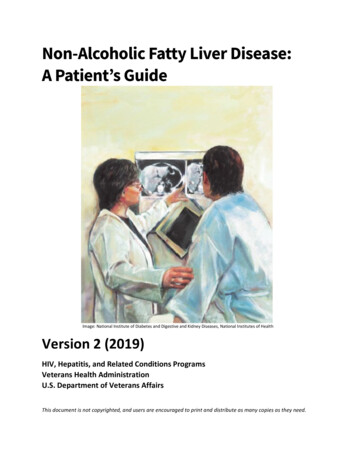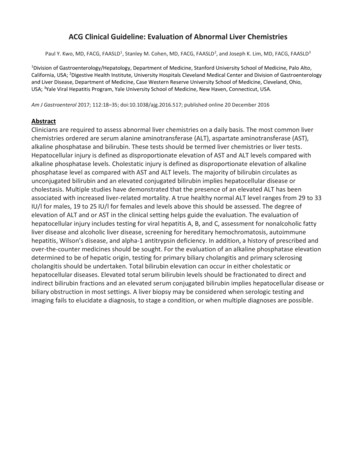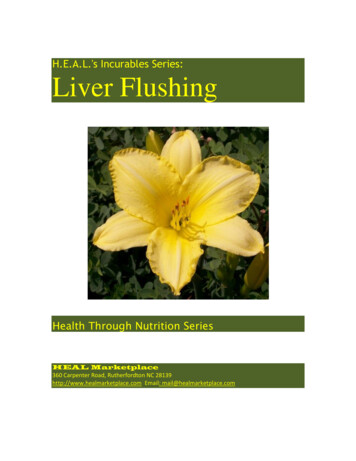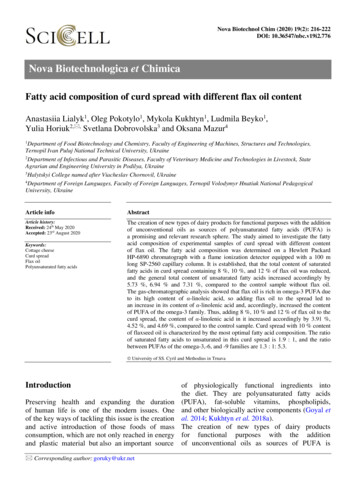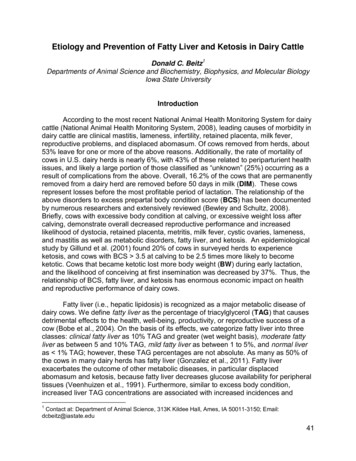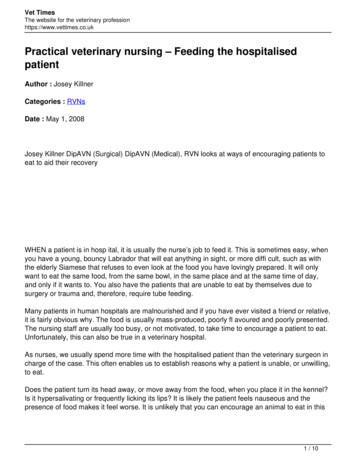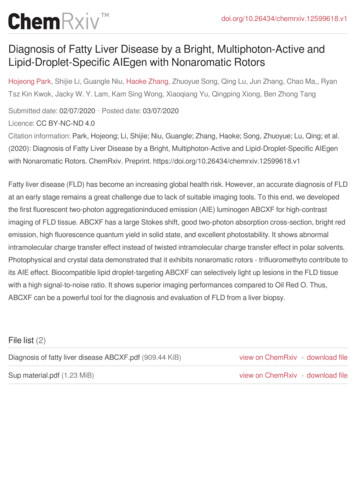
Transcription
doi.org/10.26434/chemrxiv.12599618.v1Diagnosis of Fatty Liver Disease by a Bright, Multiphoton-Active andLipid-Droplet-Specific AIEgen with Nonaromatic RotorsHojeong Park, Shijie Li, Guangle Niu, Haoke Zhang, Zhuoyue Song, Qing Lu, Jun Zhang, Chao Ma,, RyanTsz Kin Kwok, Jacky W. Y. Lam, Kam Sing Wong, Xiaoqiang Yu, Qingping Xiong, Ben Zhong TangSubmitted date: 02/07/2020 Posted date: 03/07/2020Licence: CC BY-NC-ND 4.0Citation information: Park, Hojeong; Li, Shijie; Niu, Guangle; Zhang, Haoke; Song, Zhuoyue; Lu, Qing; et al.(2020): Diagnosis of Fatty Liver Disease by a Bright, Multiphoton-Active and Lipid-Droplet-Specific AIEgenwith Nonaromatic Rotors. ChemRxiv. Preprint. https://doi.org/10.26434/chemrxiv.12599618.v1Fatty liver disease (FLD) has become an increasing global health risk. However, an accurate diagnosis of FLDat an early stage remains a great challenge due to lack of suitable imaging tools. To this end, we developedthe first fluorescent two-photon aggregationinduced emission (AIE) luminogen ABCXF for high-contrastimaging of FLD tissue. ABCXF has a large Stokes shift, good two-photon absorption cross-section, bright redemission, high fluorescence quantum yield in solid state, and excellent photostability. It shows abnormalintramolecular charge transfer effect instead of twisted intramolecular charge transfer effect in polar solvents.Photophysical and crystal data demonstrated that it exhibits nonaromatic rotors - trifluoromethyto contribute toits AIE effect. Biocompatible lipid droplet-targeting ABCXF can selectively light up lesions in the FLD tissuewith a high signal-to-noise ratio. It shows superior imaging performances compared to Oil Red O. Thus,ABCXF can be a powerful tool for the diagnosis and evaluation of FLD from a liver biopsy.File list (2)Diagnosis of fatty liver disease ABCXF.pdf (909.44 KiB)view on ChemRxivdownload fileSup material.pdf (1.23 MiB)view on ChemRxivdownload file
Diagnosis of Fatty Liver Disease by a Bright, Multiphoton-Active andLipid-Droplet-Specific AIEgen with Nonaromatic RotorsHojeong Park,[a,b] Shijie Li,[c] Guangle Niu,[a,b,d] Haoke Zhang,[a,b] Zhuoyue Song,[c] Qing Lu,[d] JunZhang,[a] Chao Ma,[e] Ryan T. K. Kwok,[a,b] Jacky W. Y. Lam,[a,b] Kam Sing Wong,[e] Xiaoqiang Yu,[d]Qingping Xiong*[c,f] and Ben Zhong Tang*[a,b,g][a][b][c][d][e][f][g][ ]H. Park, Prof. G. Niu, Dr. H. Zhang, Prof. Jun Zhang, Dr. R. T. K. Kwok, Dr. J. W. Y. Lam, Prof. B. Z. TangDepartment of Chemistry, The Hong Kong Branch of Chinese National Engineering Research Center for Tissue Restoration and Reconstruction, Institutefor Advanced Study, State Key Laboratory of Neuroscience, Division of Life Science and Department of Chemical and Biological Engineering, The HongKong University of Science and Technology, Clear Water Bay, Kowloon, Hong Kong 999077, ChinaE-mail: tangbenz@ust.hkH. Park, Prof. G. Niu, Dr. H. Zhang, Dr. R. T. K. Kwok, Dr. J. W. Y. Lam, Prof. B. Z. TangHKUST-Shenzhen Research Institute, No. 9 Yuexing 1st RD, South Area, Hi-tech Park, Nanshan, Shenzhen 518057, ChinaDr. S. Li, Dr. Z. Song, Prof. Q. XiongClinical Medical College of Acupuncture Moxibustion and Rehabilitation, Mathematical Engineering Academy of Chinese Medicine, Guangzhou Universityof Chinese Medicine, Guangzhou 510006, ChinaE-mail: qpxiong@gmail.comProf. G. Niu, Q. Lu, Prof. X. YuCenter of Bio and Micro/Nano Functional Materials, State Key Laboratory of Crystal Materials, Shandong University, Jinan 250100, ChinaC. Ma, Prof. K. S. WongDepartment of Physics, The Hong Kong University of Science and Technology, Clear Water Bay, Kowloon, Hong Kong 999077, ChinaProf. Q. XiongJiangsu Key Laboratory of Regional Resource Exploitation and Medicinal Research, Faculty of Chemical Engineering, Huaiyin Institute of Technology,Huai'an 223003, Jiangsu, ChinaE-mail: qpxiong@gmail.comProf. B. Z. TangCenter for Aggregation-Induced Emission, SCUT-HKUST Joint Research Institute, State Key Laboratory of Luminescent Materials and Devices, SouthChina University of Technology, Guangzhou 510640, ChinaThese authors contributed equally to this work.Supporting information for this article is given via a link at the end of the document.non-alcoholic FLD is reversible and managed through adjustmentin diet and physical activities before progressing into more severeadvanced stages including cirrhosis and hepatocellularcarcinoma.[5] Therefore, an early diagnosis of FLD with a reliabledetection method is paramount importance to the patients’prognostic outcome.Several imaging-based methods have been developed for thediagnosis of FLD including computed tomography (CT), magneticresonance imaging (MRI), and ultrasonography (US). However,CT requires a high level of exposure to X-ray radiation and MRImay be problematic for patients with uneven fatty change as itonly allows them to evaluate a small sample volume. [6] The majordownfall of the US is its high technical failure rate in morbidlyobese patients.[7] All these methods also suffer from the lowdetection sensitivity. On the other hand, the ratio of the level ofalanine transaminase (ALT) and aspartate transaminase (AST)which are important in the liver function, in blood may aid thediagnosis of FLD. Yet, as over 80% of the biochemistry remainsnormal, blood test based on the liver enzyme detection probablyleads to patients remaining undiagnosed and untreated.[8, 9] Thus,it’s in great demand for a simple and reliable detection techniquefor the examination of the liver condition.In the modern clinical setting, diazo dyes such as Oil Red O arewidely used for the diagnosis of FLD by histological staining oflipid droplets (LDs).[10] Unfortunately, the performance is ratherunreliable. Apart from their unstable chemical structures and lackof selectivity toward LDs, the sample preparation using thesedyes is extremely time-consuming, and the use of organicsolvents like ethanol and isopropanol during the stainingprocedure due to their poor solubility may cause artificial fusion ofLDs.[11] Furthermore, the shallow penetration in tissue fails toaccurately visualize LDs via the conventional light microscopy. [12]Recently, fluorescence microscopy is widely utilized forAbstract: Fatty liver disease (FLD) has become an increasing globalhealth risk. However, an accurate diagnosis of FLD at an early stageremains a great challenge due to lack of suitable imaging tools. Tothis end, we developed the first fluorescent two-photon aggregationinduced emission (AIE) luminogen ABCXF for high-contrast imagingof FLD tissue. ABCXF has a large Stokes shift, good two-photonabsorption cross-section, bright red emission, high fluorescencequantum yield in solid state, and excellent photostability. It showsabnormal intramolecular charge transfer effect instead of twistedintramolecular charge transfer effect in polar solvents. Photophysicaland crystal data demonstrated that it exhibits nonaromatic rotors trifluoromethyto contribute to its AIE effect. Biocompatible lipiddroplet-targeting ABCXF can selectively light up lesions in the FLDtissue with a high signal-to-noise ratio. It shows superior imagingperformances compared to Oil Red O. Thus, ABCXF can be apowerful tool for the diagnosis and evaluation of FLD from a liverbiopsy.IntroductionAt present, human health is highly threatened by various kinds ofdiseases. Hepatic steatosis, commonly known as fatty liverdisease (FLD), is a medical condition where excess lipid dropletsaccumulate in hepatocytes in the form of triglyceride. [1] It iscategorized into two types: non-alcoholic fatty liver disease andalcoholic liver disease.[2] Recently, non-alcoholic FLD is receivingconsiderable attention as the prevalence of non-alcoholic FLDhas increased to about 25% of the global population while noapproved medication is available for the disease in the market. [3]Non-alcoholic FLD is known to be strongly associated withcharacteristics of metabolic syndromes, such as obesity, type-2diabetes, dyslipidaemia and hypertension.[1, 4] An early stage of1
toluene.[41a] The authors concluded that the intramolecularmotions of the nonaromatic rotor of the TMS group quench theemission in solution and the restricted rotation of suchnonaromatic rotor is most likely responsible for the boostedemission in crystals. Indeed, in our previous work, we observedan abnormal phenomenon of one trifluoroacetyl group replacedcompound 2,2,2-trifluoroacetamide) with no emission in solution oraggregate state, which was completely AIE inactive.[41b] However,another acetyl group substituted compound cetamide was AIE active. Wenoticed that the trifluoromethyl group (CF3) is also a nonaromaticrotor ascribed to the no emission of compound 2,2,2-trifluoroacetamide).Based on this, we anticipated that the introduction of nonaromaticrotor CF3 group could be a promising design strategy to maintainthe good π-conjugation of AIEgens as well as favorable ICT effect.With these considerations in mind, we designed and synthesizeda new donor and acceptor incorporated fluorescent two-photoncompound ABCXF by decorating the nonaromatic rotor (CF3) onthe conjugated core. As we expected, single-crystal dataindicates the planar structure of ABCXF. ABCXF is AIE-active andhighly red-emissive in solid state. The abnormal ICT effect of thisAIEgen was verified by investigating the fluorescence data indifferent polar solvents. Combined photophysical and crystal datarevealed that nonaromatic rotors (CF3) in ABCXF contribute to itsAIE effect. Given its lipophilic structure, in vitro imaging dataconfirmed the high specificity of ABCXF in LDs. Compared withmost LD dyes with complicated synthesis procedures, ABCXFwas simply obtained via one-step synthesis. It was further utilizedfor the diagnosis of FLD obtained from guinea pig FLD tissues byone-photon and two-photon microscopy and the photostability ofABCXF under continuous one- and two-photon irradiation wasinvestigated.monitoring cell physiology and medical diagnosis due to its highsensitivity, selectivity, non-invasiveness and ability to provideexcellent spatial and temporal resolution. [13-15] Two commerciallyavailable probes Nile Red and BODIPY493/503 are commonlyused for LDs staining.[16] However, Nile Red suffers from highunspecific background fluorescence signal and broad emissionpeak which hinders its use in multi-color imaging.BODIPY493/503 exhibits small Stoke shifts to cause nonradiative energy loss and interference from the scattered light. [17,18]Although some attempts have been made to develop newfluorescent probes for selective imaging of LDs,[19-21] fluorescentprobes have been rarely utilized in the diagnosis of FLD due totheir unsatisfying permeability, limited tissue penetration, andpoor signal-to-noise ratio.[22] Generally, most of these reportedprobes usually work at low concentrations but their photostabilityby continuous irradiation especially high-intensity two-photonlaser is under concern. On the other hand, increasing theconcentration of the hydrophobic traditional dyes leads menon.[23] Therefore, it is necessary and meaningful todevelop ACQ-free and highly photostable fluorescent LD-specificprobes for the diagnosis of FLD.In 2001, our group coined the concept of aggregation-inducedemission (AIE) which is the exact opposite of ACQ effect.[24] AIEluminogens (AIEgen) show non-emissive or weekly emissive insolutions but brightly emissive upon aggregation or in solid statethrough a mechanism of the restriction of intramolecular motions(RIM).[25, 26] Based on RIM, numerous AIEgens have beendeveloped for various biological applications such asfluorescence imaging, biosensing, and disease diagnosis. [27-32]Compared with one-photon imaging, multiphoton like two-photonimaging using near-infrared excitation is more suitable inbiomedical imaging because of the minimal backgroundautofluorescence, low photobleaching, high spatial resolution,and deep tissue penetration.[33] Considering their highfluorescence brightness and photostability, AIEgens are naturallystable and promising candidates for two-photon imaging.[34-36]Since liver tissue suffers from the autofluorescence covering thewhole visible light region, it would be ideal to develop a novelmultiphoton-active AIEgen.[37] Conventionally, the introduction ofthe electron donor-acceptor (D-A) group into a π-conjugatedsystem is a frequently used strategy to construct two-photonactive fluorescent dyes.[38] Such a strategy generally results inintramolecular charge transfer (ICT), which is beneficial forenhancing the electron mobility and red-shifted and intensityincreased fluorescence. While most AIEgens show twistedintramolecular charge transfer (TICT) property rather than ICTeffect, due to their highly twisted structures.[39] Pure TICT effect isdetrimental for bioimaging because of the high polar waterenvironment in biological system.[40] Therefore, the key to developICT-based AIEgens is to inhibit TICT effect in a D-A system byconstructing a planar core. As the highly twisted AIEgens withnumerous aromatic rings and rotors have the flexible cores,seeking some pendent nonaromatic rotors on the fluorescentplanar cores probably leads to novel D-A based AIEgens withfavorable ICT effect.Recently, few potential bulky nonaromatic rotors have beenreported.[41] Panigati et al. developed a TMS (Me3Si) groupsubstituted dinuclear rhenium complex with bright solid-stateemissions of fluorescence quantum yield of over 50%, while itshowed faint emission (fluorescence quantum yield of 6%) inResults and DiscussionThe synthesis route of ABCXF is depicted in Figure 1A. ABCXFwas facilely obtained through a simple one-step nucleophilicreaction. Commercially available compound 1 and compound 2were reacted in anhydrous EtOH in the presence of t-BuONa at90 C to yield ABCXF. ABCXF was characterized by 1H NMR, 13CNMR, 19F NMR, and HRMS spectroscopy (Figures S1-S4). Adetailed synthetic procedure was provided in the SupportingInformation. The structure of ABCXF was confirmed by the singlecrystal structure analysis (Figure 1B). It clearly shows that ABCXFalmost exhibits a planar structure with a very small twisted angleof 10.55º between the trifluoromethyl substituted benzene planeand the other π-conjugated part of the molecule. The singlecrystal suitable for single-crystal analysis was obtained by slowevaporation of the solvent mixture of CH2Cl2 and MeOH (3:1, v/v)at room temperature. The details of the X-ray experimentalconditions, cell data, and refinement data of ABCXF aresummarized in Table S1. Additionally, DFT calculation wasperformed with the method of b3lyp/6-31g(d,p) by using theGaussian 09 program package (Figure 1C). [42] The highestoccupied molecular orbital (HOMO) was mostly delocalized onthe other part of the molecule except for thetrifluoromethylphenzene moiety, whereas the lowest unoccupiedmolecular orbital (LUMO) was delocalized on the2
of THF. Hydrated diameter: 154 nm. (D) Normalized FL spectra of amorphousABCXF solid. Inset: fluorescent photograph of ABCXF taken under 365 nm UVirradiation.trifluoromethylphenyl substituted acrylonitrile unit. The energybandgap between HOMO and LUMO was 2.92 eV. The D-Abased ABCXF showed typical charge transfer characteristics aswe expected.We then systematically investigated its photophysical data. Asshown in Figure S5, ABCXF possesses an absorption maximum( abs) at 448 nm in THF which falls in the range of visible lightallowing less photodamage to the biological system compared toUV light. The AIE property of ABCXF was studied in THF/watermixture with different water fractions (fw) (Figure 2A, 2B, and S6).ABCXF shows an emission maximum ( em) at 579 nm in THFsolution and a large Stokes shift of 131 nm. With the addition ofwater to the THF solution, its emission showed red shift and itsintensity slightly increased as it reached fw 70%. At fw 95%,ABCXF showed the highest FL emission at 585 nm because ofthe formation of aggregates, indicating the aggregation-enhancedemission (AEE) property. A shoulder peak at about 605 nm alsoexists, due to different intermolecular interactions betweenABCXF molecules in nanoaggregates. As water fraction furtherincreased to 99%, the FL intensity drastically decreased. Such aphenomenon has been frequently reported and explained due toa change in morphology and size of nanoparticles at high waterfraction.[25, 43] It is noteworthy that the ratio of FL increase at fw 95% compared to 0% is only 10 folds (Figure 2B), possiblyindicating the formation of loose packing aggregates. The lightdynamic scattering measurements show the presence ofnanoaggregates in fw 95% and 99% with the size about 153 nmand 143 nm in diameter, respectively (Figure 2C and S7). ABCXFemits red-shifted emission (647 nm) in solid state compared withthat in solution (Figure 2D). Before analyzing the intermolecularpacking mode of ABCXF in the crystal to explain the red-shiftedsolid-state emission, we first recorded the X-ray diffraction (XRD)pattern of a pristine solid sample. As shown in Figure S8, its XRDpattern was very similar to the simulated XRD pattern from X-raysingle crystal data, indicating the easy crystallization of ABCXFand similar interactions in pristine samples. Then, theintermolecular packing mode of ABCXF in the crystal wasanalyzed (Figure S9). It showed that some ··· interactionsbetween the electron-donating and withdrawing groups, resultingin strong intermolecular D-A interactions and red-shifted emissionin solid state. Generally, previously developed AIEgens possesshighly twisted structures due to the presence of multiple aromaticrotors, and restriction of the movement of these rotors is known tobe the cause of AIE phenomena. However, in the case of ABCXF,except for intermolecular C‒H··· interactions, multipleintermolecular C‒H···F interactions between adjacent moleculesare also formed, indicating the motion inhibition of phenyl unitsand the CF3 group. In addition, the disordered assembly of theCF3 group attached to the phenyl could be observed (FigureS10),[44] further confirming the free motion of CF3 groups insolution state but inhibited motion by crystal lattice in solid state.The restricted molecular motion of the nonaromatic rotor (CF3group) together with the aromatic rotors like phenyl groupcontributes to preventing the loss of excited-state energy vianonradiative decay channels, resulting in bright emission in solidstate. After strong grinding of the solid ABCXF, the fluorescenceshowed only slight blue shift with a maximum wavelength of 625nm (Figure S11), indicating stable intermolecular interactions.The absolute fluorescence quantum yield (QY) of ABCXF in solidstate and diluted THF solution was measured using an integratingsphere. In the diluted THF solution, the fluorescence QY ofFigure 1. (A) Synthetic route of ABCXF. (B) ORTEP drawing of single crystalstructure of ABCXF with atoms labelled in colour at different directions. CCDC1904764. C, gray; H, white; F, green; N, blue. (C) Frontier molecular orbitals ofABCXF calculated with the method of b3lyp/6-31g(d,p) by using the Gaussian09 program package, HOMO: highest occupied molecular orbital, LUMO: lowestunoccupied molecular orbital.Figure 2. (A) FL spectra of ABCXF (10 M) in THF/water mixtures with differentwater fractions (fw). (B) The plot of FL emission intensity versus the compositionof THF/water mixture containing ABCXF. Inset: fluorescent photographs ofABCXF in THF/water mixtures with different water fractions under 365 nm UVirradiation. (C) Dynamic light scattering data of ABCXF in water containing 5%3
ABCXF is only 0.8 % as the active intramolecular motionconsumed the energy of the excited state through non-radiativeprocesses. However, in solid state, ABCXF is highly emissive withthe fluorescence QY of 15.9 % due to restriction of intramolecularmotion (Figure 2D).femtosecond pulse laser (800-1000nm) excited fluorescence andRhodamine B as the standard,[46] we measured the two-photonabsorption (TPA) cross section of ABCXF at differentwavelengths. As displayed in Figure 3D, ABCXF has themaximum TPA cross section value of 180 GM at 850 nm. Thisresult indicates that ABCXF is a good candidate to be utilized fortwo-photon fluorescence imaging.Figure 3. (A) FL spectra of ABCXF (10 M) in different polar solvents. (B) FLspectra of ABCXF (5 μM) in methanol and methanol/glycerol mixture withdifferent glycerol fractions (fG). (C) FL spectra of ABCXF (1 M) in PBS solution(pH 7.2) with and without DMPC (40 g/mL) and TAG (80 g/mL). (D) Twophoton absorption (TPA) cross sections of ABCXF in THF. 1 GM 10-50 cm4s/photon.As ABCXF is a donor-acceptor conjugated -system, it isanticipated to display distinct fluorescence changes in differentpolar solvents. The em of ABCXF gradually red-shifted from 550to 620 nm with an increase in fluorescence intensity as the solventpolarity increased from toluene to DMSO (Figure 3A). Thefluorescence QYs of ABCXF in different solvents were alsorecorded using an integrating sphere (Table S2). Theseinteresting data together with the planar structure indicated thatABCXF shows positive solvatochromism in different polarsolvents due to the ICT effect not TICT effect. Otherwise, thefluorescence intensity of ABCXF in high polar solvent like DMSOshould greatly decrease. We further studied the effect of viscosityon ABCXF in glycerol/ MeOH mixture with different fractions ofglycerol. As shown in Figure 3B, the fluorescence enhancementwas observed as the viscosity of the solvent increased, which isalso demonstrated the AIE effect of ABCXF. Given the lipophilicityof ABCXF with a calculated logP (n-octanol/water partitioncoefficient) value of 5.842, we anticipated that ABCXF probably isan LD-specific dye.[45] Therefore, we studied the photophysicalproperty of ABCXF in the presence of 1,2-dimyristoyl-sn-glycero3-phosphocholine (DMPC) and trioleate glycerol (TAG) in PBS tomimic the environment of LDs. The chemical structures of DMPCand TAG were displayed in Figure S12. As shown in Figure 3C,in the presence of key components of LDs, ABCXF displayedblue-shifted and enhanced fluorescence (about 3-fold) at about525 nm compared to ABCXF only, which is beneficial for light-upfluorescence imaging in biological systems. By using theFigure 4. (A) Confocal laser scanning microscopy ( ex 488 nm) images ofHeLa cells stained with ABCXF (200 nM) and Nile Red (200 nM). Scale bar: 10 m. (B) Confocal laser scanning microscopy ( ex 488 nm) images of HeLa andHepG2 cells stained with ABCXF (200 nM) and MeOTTMN (2 M). Scale bar:10 m.Before evaluating its biological imaging applications, we firststudied the cytotoxicity of ABCXF in HeLa and HepG2 cells by thestandard MTT assay. Approximately 5000 cells were plated ineach well of 96 well plate and after cells adhered to the platesurface, medium containing a range of concentration of ABCXFwas added to each well. Over the range of concentration from 0.5to 10 M, ABCXF shows negligible cytotoxicity in both HeLa andHepG2 cells (Figure S13). Subsequently, live-cell imaging inHeLa and HepG2 cells were performed within the concentrationrange tested for the MTT assay by confocal laser scanningmicroscopy. After incubation of ABCXF at 200 nM for 20 min,bright spots in HeLa and HepG2 cells could be visualized with ahigh signal-to-noise ratio (Figures 4A and S14), probablyindicating its location in LDs. However, the commercially availabledye, Nile Red showed bright emission in LDs as well as nonspecific fluorescence in the cytoplasm under the same condition,resulting in unsatisfying imaging contrast. The in situ fluorescencespectra of ABCXF in HeLa and HepG2 were acquired using theLambda mode, and the data revealed that ABCXF exhibited blue-4
m. (C) One-photon ( ex 488 nm) and two-photon ( ex 850nm) fluorescentimages of high-fat feeding guinea pig liver tissue stained with ABCXF (1 M).Scale bar: 20 m.shifted in situ fluorescence (about 550-555 nm) in live cells due toits ICT characteristic and the low polar environment of LDs (FigureS15). Considering the spectra overlap between ABCXF and NileRed, we used another previously developed red/near-infraredprobe MeOTTMN for co-stain experiments. As shown in Figure4B, ABCXF showed excellent overlap with MeOTTMN withPearson’s coefficient value of 0.94 and 0.96 in HeLa and HepG2cells, respectively. These data demonstrated that our AIEgenABCXF is a suitable LD probe that works at an ultralowconcentration of 200 nM for specific LDs staining with a highsignal-to-noise ratio.As previous studies have shown that the hallmark of FLD is theexcess lipid accumulation in the liver tissue. [1a, 47] ABXCF’s abilityto specifically stain LDs motivated us to investigate its ability tovisualize LDs in lesions of the FLD tissue. We built a FLD modelby providing a high-fat feeding diet to a group of male Hartleyguinea pigs and as a control, a group of guinea pigs were fed witha normal diet under the same experimental conditions. [48] Afterfive weeks of feeding, the livers were taken from the guinea pigsin both groups and the livers were sliced by a cryostat. Thesectioned tissues were incubated with ABCXF for 1 h before theimaging. As predicted, ABCXF showed a strong yellowfluorescence in the FLD tissue from the high-fat feeding guineapig (Figure 5A), due to its ICT effect and the viscous and low polarlipid environment (Figure 3C). Surprisingly, only very faintemission was collected in the control group because of the strongAIE effect. We performed co-stain experiment to confirm thestaining location in lesions of the FLD tissue (Figure 5B). The datashowed that ABCXF could specifically stain LDs with a highfluorescence overlap with that of MeOTTMN (Pearson’scoefficient value of 0.92). Compared to previously developed twofluorescent probes for the FLD tissue imaging with the strongbackground fluorescence,[49, 19] ABCXF showed a highly improvedsignal-to-noise ratio. Such remarkable imaging contrast indicatedthat our LD-specific AIEgen ABCXF exhibit much potential indiagnosis of FLD.Compared with one-photon fluorescence imaging, two-photonfluorescence imaging with a near-infrared excitation light is apromising imaging technique as the scattering coefficient is lowerand the focus range is narrower, thus providing some outstandingadvantages of deep tissue penetration, reduced photobleachingand lower phototoxicity.[50] Considering the good two-photonabsorption cross-section (about 180 GM at 850 nm) of ABCXF,we carried out two-photon imaging of ABCXF in the FLD tissue.After incubation with ABCXF for 1 h, strong two-photon excitedfluorescence signals in LDs were detected and showed a goodoverlap with one-photon excited fluorescence signals (Figure 5C).It should be noted that the two-photo[n fluorescence imagingdisplayed lower background fluorescence compared to the onephoton imaging.Figure 5. (A) One-photon ( ex 488 nm) fluorescent images of normal and highfat feeding guinea pig liver tissue stained with ABCXF (1 M). Scale bar: 20 m.(B) One-photon ( ex 488 nm) fluorescent images of high-fat feeding guinea pigliver tissue stained with ABCXF (1 M) and MeOTTMN (1 M). Scale bar: 205
Figure 6. (A) Two-photon (λex 850 nm) fluorescent images of the high-fat feeding guinea pig liver tissue stained with ABCXF (2 M) at different penetration depths.Scale bar: 20 μm. (B) Reconstructed 3D two-photon fluorescent images. (C) Bright-field and fluorescent images of the high-fat feeding guinea pig liver tissue stainedwith Oil Red O and ABCXF (1 μM), respectively, at different time points. Scale bar: 50 μm (Upper) or 20 μm (Lower). (D) Normalized color and fluorescenceintensities obtained from images of the high-fat feeding guinea pig liver tissue stained with Oil Red O and ABCXF, respectively, at different time points.One of the most outstanding merits of two-photon fluorescenceimaging is that it enables deep penetration depth in tissue imaging.Considering the high-contrast two-photon imaging of ABCXF inlesions of 10 m-thick FLD tissue, we investigated its penetrationdepth with a 100 m-thick FLD tissue. The fluorescent imageswere captured every 3 m along the z-axis. Under the excitationof 850 nm, the spherical LDs in the tissue sample were observedalong the z-axis up to a depth of 42 m (Figure 6A), and the 3Dtwo-photon fluorescent image was successfully constructed witha high resolution (Figure 6B). However, compared to the twophoton imaging, the one-photon fluorescence imaging of ABCXFunder 488 nm excitation only showed a shallow penetration depthof less than 30 m along the z-axis (Figure S16). These datademonstrate that ABCXF can be used for visualization of LDs inlesions of the FLD tissue with a sufficient tissue penetration depth.Oil Red O has been used for visualization of lipid and fatdeposits in cell and tissue over the past decades under the brightfield microscopy. Especially, Oil Red O staining has been widelyused as a histochemical stain for quantifying liver steatosis in liverbiopsy samples. However, the Oil Red O staining method suffersfrom a low sensitivity and shallow tissue penetration compared tothe fluorescence imaging method.[12, 51] Moreover, Oil Red Ostained tissue must be analyzed within 24 h of staining due to itschemical instability and possible fusions of adjacent LDs. [11b] Westained the FLD tissue with Oil Red O and ABCXF separately tocompare their imaging performances at the different time pointsof 0, 12, 24, and 48 h (Figure 6C and 6D). After 48 h of staining,the color of Oil Red O was dramatically faded and the intensityonly remained 60% of the initial color intensity. However, thefluorescence intensity of ABCXF remained above 90% even after48 h, demonstrating its superior tissue imaging performance overOil Red O for the diagnosis of FLD.Figure 7.
develop ACQ-free and highly photostable fluorescent LD-specific probes for the diagnosis of FLD. In 2001, our group coined the concept of aggregation-induced emission (AIE) which is the exact opposite of ACQ effect.[24] AIE luminogens (AIEgen) show non-emissive or weekly emissive in solutions but brightly emissive upon aggregation or in solid state
